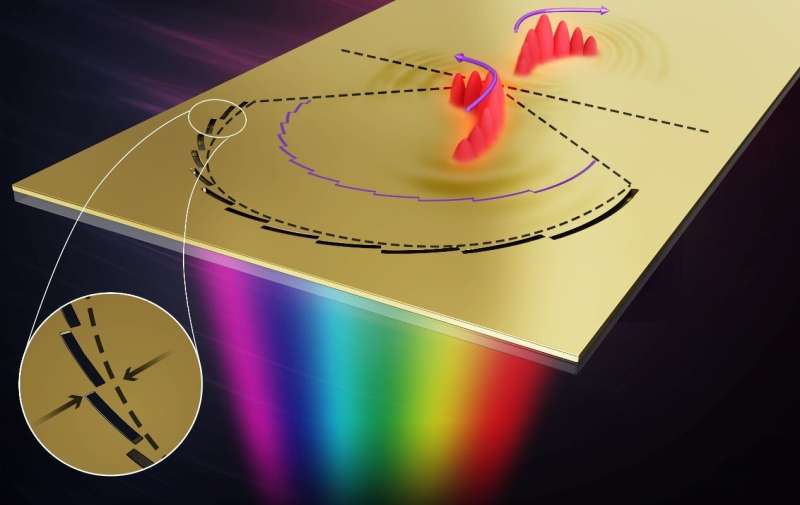Spatiotemporal manipulation of femtosecond light pulses for on-chip devices

A new publication from Opto-Electronic Advances discusses spatiotemporal manipulation of femtosecond light pulses for on-chip devices.
With the development of highly integrated nanophotonic devices, researchers have begun to pursue new methods of flexibly manipulating the on-chip light signals in both extremely small spatial scale (e.g., nanometer) and ultrafast temporal scale (e.g., femtosecond). The control of optical signals in nanometer and femtosecond scales not only provides fundamental insights into the ultrafast dynamics of the interaction between light and matter, but also offers an effective platform for high-efficiency ultrafast signal processing in integrated nanophotonic devices, and optical detection and imaging with super-spatiotemporal resolution. Thus, research of spatiotemporal light-field manipulation is of great significance and can be widely applied in the fields of photonic circuits, photonic information processing, quantum information processing, neuromorphic computing and artificial intelligence, and ultrafast optical wavefront measurement.
For the spatial modulation of light in nanoscale, in recent years some new optical devices such as metamaterials and metasurfaces have been rapidly developed to precisely control the behavior of micro- and nano-scale optical field. For example, the propagation of optical signals can be modulated to a curved trajectory as the Airy beam. For the modulation in time domain, the traditional methods, including dynamically controlled equipment (such as SLM) or actively controlled materials (such as electro-optical materials), suffer from the limited response time of materials and are not suitable for ultrafast modulation of femtosecond light pulses.
Recently, with the development of pulse shaping technology, frequency-domain modulation has gradually become the main means of ultrafast modulation on femtosecond pulses. By combining the frequency-domain modulation method with the designed micro-/nano-structures, it is expected to achieve the light-field generation and manipulation in both nanometer and femtosecond scales, creating many novel spatiotemporal light fields and expanding new applications.
The authors of this article propose a novel method to manipulate the on-chip propagation of a femtosecond light pulse based on the spatiotemporal Fourier transform (FT). By combining the frequency-domain modulation method with the spatial modulation method, they found that the spatial distribution of the light field can be arranged by regulating the spatial domain FT with an on-chip nanofocusing structure, and the ultrafast wavefront shaping of femtosecond pulses in the time domain can be realized by adjusting the temporal FT with the dispersion effect of light. Finally, the spatiotemporal FT can be synchronized to manipulate the on-chip propagation properties of femtosecond pulses in time-space domain.
To demonstrate this spatiotemporal FT method for on-chip devices, they chose surface plasmon polaritons (SPP) excited on a metal surface as example, and studied the modulation performance on the excited femtosecond SPP pulses. With the capability of breaking through the optical diffraction limit, SPPs have widely been employed in nanophotonic devices for a variety of applications, including optical storage, optical sensing, optical tweezers, and Raman scattering. In addition to nanoscale spatial resolutions, SPP pulses generated by a femtosecond laser enable femtosecond-scale temporal resolutions, thereby providing a research platform for the manipulation of light fields and the interaction of light and matter at extremely small spatiotemporal scales.
With the proposed spatiotemporal FT modulation method, they theoretically demonstrated some extraordinary spatio-temporal modulation effects on the femtosecond SPP pulses. For example, a conventional spatial SPP focus can be gradually bent into a ring shape, and the propagation direction of a curved SPP-Airy beam can be reversed at certain moments to create an S-shaped path. Compared with conventional modulation of SPPs in either space or time domain, the proposed method offers potentially a variety of novel effects in SPP modulation especially associated with the temporal domain, thereby improving the degree of freedom of optical modulation and providing a new platform for on-chip spatiotemporal manipulation of optical pulses with applications including ultrafast on-chip photonic information processing, ultrafast pulse/beam shaping, and optical computing.
More information: Yulong Wang et al, Spatiotemporal Fourier transform with femtosecond pulses for on-chip devices, Opto-Electronic Advances (2022). DOI: 10.29026/oea.2022.210047
Provided by Compuscript Ltd





















